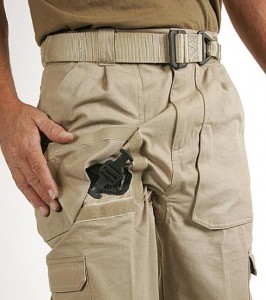The title above will be the basis for a series of articles I will write over the coming weeks outlining some cutting-edge technologies that are just being placed in the field, or will soon debut in the next few years. The events surrounding September 11th 2001 and the subsequent wars in Afghanistan and Iraq have been the catalyst for major defense research, as well as the development of some interesting and unique technologies. This series will primarily focus on technologies that will assist the soldier or tactical operator on the ground.
The majority of these new technologies are designed to reduce the fog of war by giving better situational awareness, improving the ability to track, designate or hand-off targets to other weapons systems, along with the key benefit of saving soldiers’ lives. The advantages of this research and the new technologies developed from these two wars will permeate into the civilian world at some future date.
Being a former Tactical Police Officer from 1990 through 2002, I’ve personally seen the transfer of military technology into the unit that helped us better carry out our missions to save lives. Off the top of my head, these are examples of some of those technologies introduced over that period: Thermal Imagers, Night Vision Scopes for Sniper and Assault Rifles, Gen II and Gen III Night Vision Goggles, and Digital Radios with encryption.
My first topic in this article focuses on a transformational technology that will penetrate the military, law enforcement and civilian world in a profound way. The most important aspect of this technology is that it is designed to save lives.

Blackhawk’s Integrated Tourniquet System
THE INTEGRATED TOURNIQUET SYSTEM (ITS)
The ITS system was the brainchild of a Texan surgeon by the name of Dr. Keith Rose. In 2006, Dr. Rose was in Afghanistan conducting a humanitarian medical mission in the field, doing surgery to repair children’s cleft pallets. Upon returning to Kabul from the field, he encountered a US military up-armoured Humvee that had been hit by an RPG round. The vehicle’s damage caused the doors to jam and to trap a soldier inside with a femoral artery bleed. The soldier was finally freed from the vehicle a few minutes later, but died because they weren’t able to reach him or free him in time to save his life. Dr. Rose was very affected by this tragic incident and felt it a senseless loss of life. It sparked an idea that eventually lead to the Integrated Tourniquet System (ITS). To develop the product, he teamed up with Blackhawk, a US based manufacturer of tactical equipment and clothing. Dr. Rose’s invention essentially pre-locates tourniquets within garments to stop blood loss if an extremity suffers from severe bleeding.
With the core of the body and head protected by body armor and a helmet, battlefield injuries to the extremities (arms and legs) have increased significantly. Reports indicate that vascular injuries accounted for 50-70% of all injuries treated during Operation Iraqi Freedom, and that extremity wounds were the leading cause of preventable death on the battlefield. This new technology will go a long way to reduce the incidents of preventable death from basically bleeding Each garment includes a total of four (4) tourniquets, with two (2) for each limb.
With an arterial bleed, time is of the essence. Someone could die in less than four (4) minutes if the bleeding is not stopped. The beauty of the system is that tourniquets are pre-located in the correct medical positions. There is no need to waste time looking for a tourniquet in the first aid kit. The system can be self-administered or, if the victim is unconscious, his/her teammate automatically knows the location of the tourniquets and simply activates them immediately.
This technology has already been adopted by the US Navy Seals, and I suspect other SF teams around the world will want to have access to this technology in their uniforms as well. Although the SF community is an early-adapter of this technology, my prediction is Defense Forces around the world will incorporate the system into their uniforms within the next 3-5 years. Law Enforcement will also adopt this technology, especially within the world’s Tactical Units. To the Australian and New Zealand Defense Forces, talk to me and I can steer you in the right direction regarding this technology I have a line straight to the top!
It’s a simple design invention repackaged into a functional system addressing a specific need on the battlefield. This technology will save lives…. period. This is not only a technology for military and law enforcement tactical teams, but also for the civilian market including extreme sports like hunting, mountain climbing, surfing, skiing, snowboarding and diving. Watch this space.
Blackhawk has a YouTube video demonstrating the technology, which I’ve linked here. Blackhawk also released their “Warrior Wear” line of clothing. which incorporates the ITS technology. Check out their website for more details.



It’s the first time I commented here and I must say you share us genuine, and quality information for bloggers! Good job.
p.s. You have a very good template for your blog. Where did you find it?
their strategy and their will fail in afghanistan ,fight like a loion in the battle field one can achievee his target
Thanks for this info.
As a freshly minted(2 months) EMT I can report that defense stuff has migrated to us too, in EMS. We have changed how we respond to bleeds in the extremities(National Registry Exam change). We were trained on something called the combat application tourniquet. Outstanding at occluding blood flow. But, as you state, you have to know ahead of time where it is, or you’re patient’s shock is going to get worse fast. In trauma scenes, it’s something I’ll probably keep in one of my leg pockets. Not expensive item either(32 bucks).
BTW found this blog via a link from Michael Yon
Thanks for writing this blog and doing a tough job.